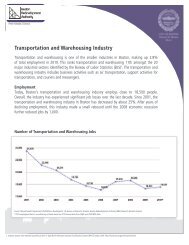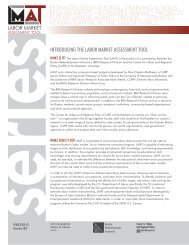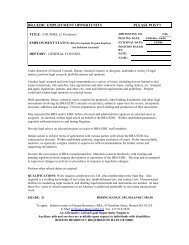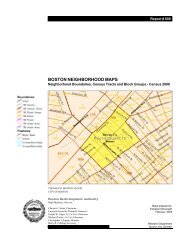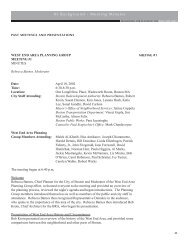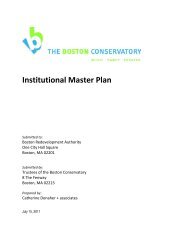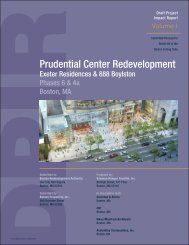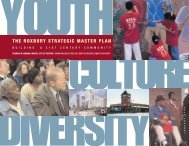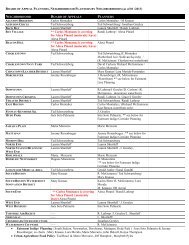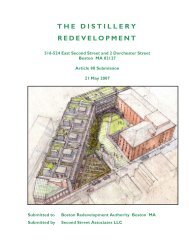point cover jan 13 - Boston Redevelopment Authority
point cover jan 13 - Boston Redevelopment Authority
point cover jan 13 - Boston Redevelopment Authority
Create successful ePaper yourself
Turn your PDF publications into a flip-book with our unique Google optimized e-Paper software.
\\MABOS\projects\1<strong>13</strong>81.00\reports\Article80\Expand<br />
ed_PNF\03_Transportation_FINAL.doc<br />
Vanasse Hangen Brustlin, Inc.<br />
The Point, <strong>Boston</strong><br />
vehicles experience significant delay and queuing while LOS F suggests unacceptable delay for the average<br />
vehicle. LOS thresholds differ for signalized and unsignalized intersections. Longer delays at signalized<br />
intersections than at unsignalized intersections are perceived as acceptable.<br />
Table 3-8 below presents the level of service delay threshold criteria as defined in the 2010 Highway Capacity<br />
Manual (HCM).<br />
Table 3-8<br />
Level of Service Criteria<br />
Level of Service<br />
3-15 Transportation<br />
Un-signalized Intersection<br />
Control Delay (sec/veh)<br />
Signalized Intersection<br />
Control Delay (sec/veh)<br />
LOS A 0-10 ≤ 10<br />
LOS B > 10-15 > 10-20<br />
LOS C > 15-25 > 20-35<br />
LOS D > 25-35 > 35-55<br />
LOS E > 35-50 > 55-80<br />
LOS F > 50 > 80<br />
Source: 2010 HCM<br />
Adjustments were made to the Synchro model to include characteristics of each intersection, such as heavy<br />
vehicles, bus operations, parking activity, and pedestrian crossings. The LOS results of the analyses are<br />
summarized in Table 3-9 for the Existing, No-Build, and Build Conditions. Detailed results including delay by<br />
approach, queuing and volume to capacity ratio are presented in Appendix B along with the detailed Synchro<br />
results.<br />
In consideration of transportation conditions in the Fenway area, it is important to be cognizant of the traffic and<br />
parking conditions associated with Red Sox home game days. However, it would not be practical to base<br />
operational analysis for the Project on the conditions that prevail under police control on the limited number of<br />
game days per year.<br />
The Boylston Street and Brookline Avenue corridors process heavy traffic and pedestrians volumes during<br />
the commuter peak hours. At times, long queue length and high vehicle delays can be observed. The traffic<br />
model includes a conservative approach to future traffic trends by forecasting an increase in background<br />
traffic and assigning specific known development projects to the study area as required by the <strong>Boston</strong><br />
Transportation Department. The model also includes several planned infrastructure projects that will benefit<br />
traffic operations in the neighborhood. These changes assumed under the No Build Condition include:<br />
New Street – this two-way roadway, to be built as part of the Fenway Triangle Mixed Use Project, will<br />
connect Boylston Street and Van Ness Street and will help alleviate traffic demands on Kilmarnock Street<br />
and Van Ness Street.<br />
Two-way Van Ness Street – planned changes to make Van Ness Street two-way between Kilmarnock Street<br />
and Jersey Street/Yawkey Way will improve traffic circulation in the neighborhood. This change is being<br />
made as part of the Fenway Triangle Mixed Use Project.<br />
Sear’s Rotary Reconstruction – this Army Corps of Engineers Project will eliminate the existing jug handle<br />
that existing today and will provide a new Riverway connection to Park Drive thus removing a portion of



